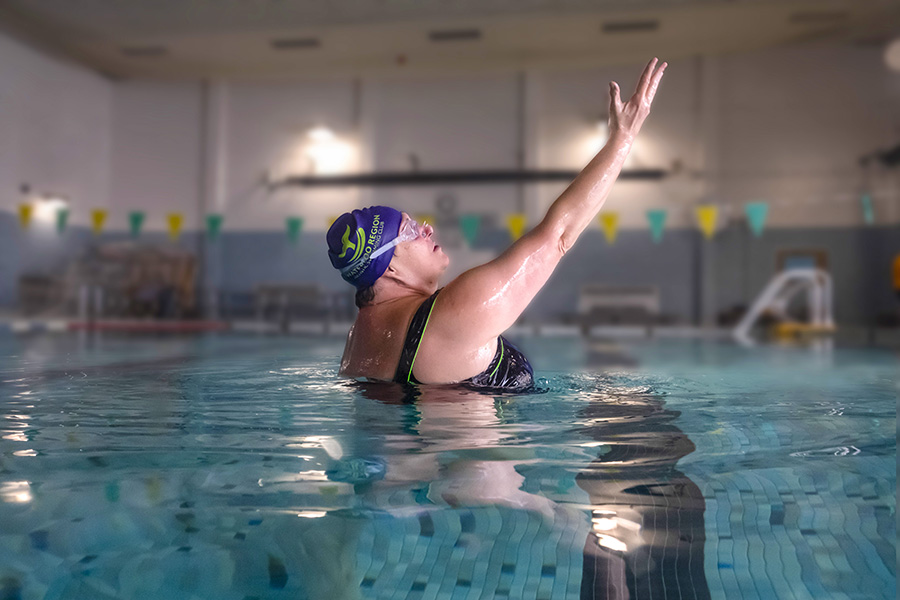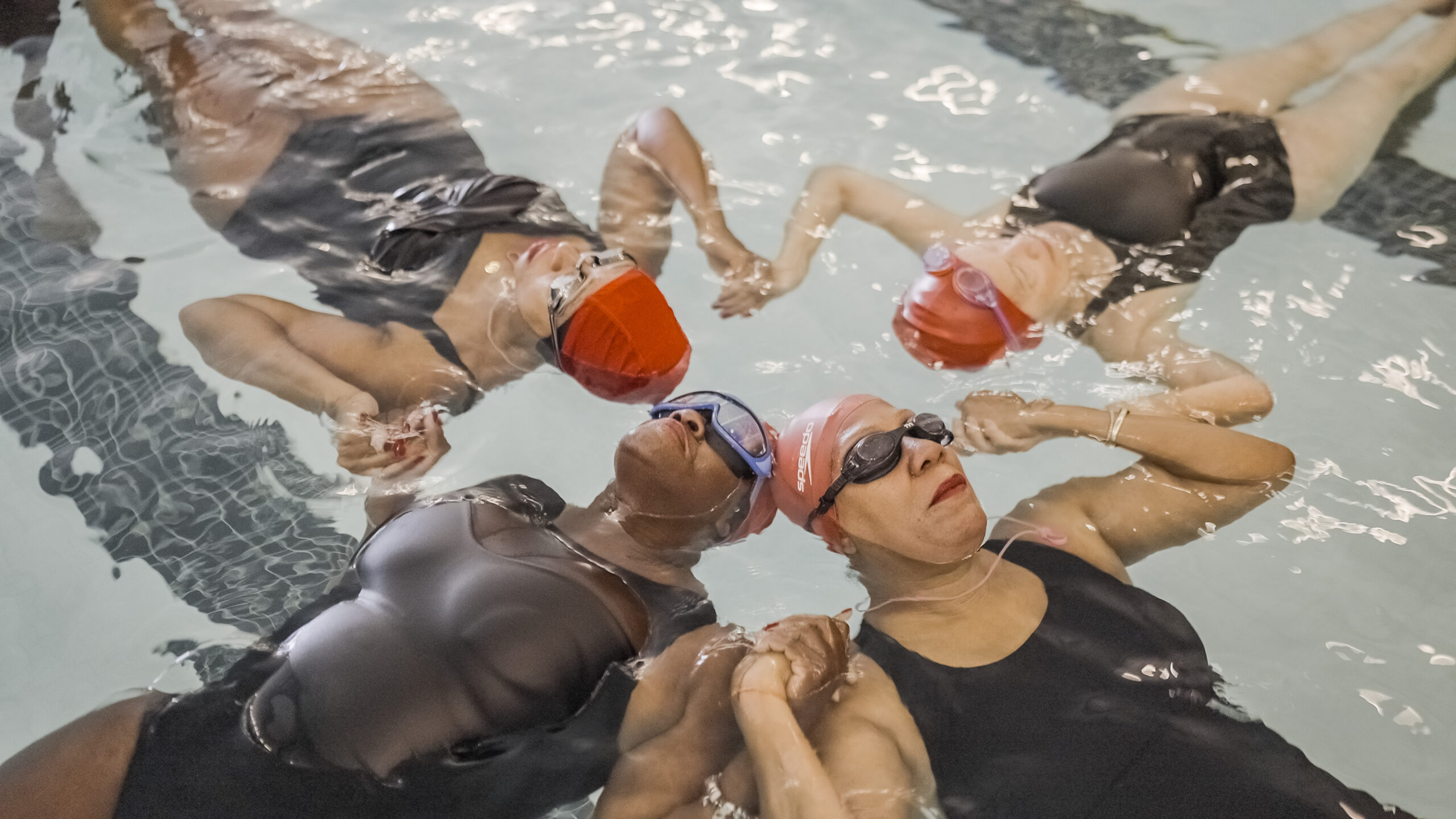‘Unsyncable:’ New Doc on VisionTV Highlights the Healing Power of Swimming as We Age

Masters synchronized swimmer Sue Baross Nesbitt, 68, and the Unsyncables of La Mirada. Photo: Courtesy of VisionTV
Artistic swimming, formerly called synchronized swimming but renamed in 2017 — where swimmers complete choreographed routines in the pool either alone or in concert with others — gives a triple boost for aging well. It provides excellent but low-impact exercise, requires memory and lets aquanauts socialize and build rapport with like-minded others.
That’s the unmissable takeaway from Unsyncable, an upbeat and hugely watchable documentary from Nova Scotia-based writer-director Megan Wennberg, which debuted to acclaim last spring at the Hot Docs festival and is making its world broadcast debut Oct. 9, 9 p.m. EDT/6 p.m. PDT on VisionTV.
Unsyncable follows the trajectories of six artistic (or self-described “synchro”) swimmers, aged 63 to 82, from the U.S. and Canada, five of whom venture to the U.S. Masters Artistic Swimming Championships, held last autumn in Maine.
In the lead-up to the competition, we watch as these six athletes — world champion synchro legend Sue Baross Nesbitt, rookie Ellen Scott, Cris Meier-Windes of the San Francisco Tsunami LGBTQ+ team, former marine Luther Gales, and his teammates Monica Hale and Joyce Clarke of the Harlem Honeys and Bears, North America’s only all-Black artistic swimming team — overcome varying challenges to achieve personal bests and, in some cases, medals.
While all swimmers forge important, bonding relationships along the way, the main impetus for swimming is clear: Keeping the body and the mind fit as the years advance.
Kitchener Ont.’s Ellen Scott, now 64 and the aforementioned “rookie,” says in the film, “Synchro gave me back my self-esteem, my self-confidence, my self-everything. People look at me in the water and they go, ‘Wow, that’s amazing!’ I don’t have to tell them that my knee aches and my neck aches,” she howls, “or that I need special shoes to walk to the bus.”
While Scott didn’t compete with the others in Maine, her artistic swimming story is especially noteworthy, as Unsyncable reveals. Indeed, as the effervescent Scott tells Zoomer, discovering the sport in 2010 was a total game changer.

Kim Hughes: How did you get on the filmmaker’s radar?
Ellen Scott: They were looking for swimmers and they somehow obtained the video of the solo competition of the Canadian Nationals that were held in Quebec City in 2019. They saw my performance. In synchro, there is something called a walk-on, which is how the swimmer walks onto the platform before beginning their routine [in the pool]. These days, that’s marked in competition. It’s only about 30 seconds but it’s a big deal. Anyway, I was trying to think about different ways to walk on. I decided to snap my fingers. When Megan (Wennberg, Unsyncable’s writer-director) saw that, she figured I had the right attitude for the film.
KH: You mention in the film that a doctor of yours first pointed you towards the pool.
ES: I have chronic pain from fibromyalgia, and I made the mistake that so many people make when the body is hurting. Instead of moving more, I moved less. At one point, I could hardly hold my head up.
It sounds counterintuitive, but movement makes pain better. For me, the water was healing, both physically and for mental health issues I have stemming from trauma suffered as a teenager. The catch was, I had to go into the pool five times a week. Six months later, I went from struggling just to walk from the bus stop to the pool to being able to walk for 20 minutes. It wasn’t easy but that made it more desirable.
This is a sport where you can show up the very first day and feel like maybe you can be successful at it. Ten years later there are still plenty of challenges to master. [At one humorous point at the start of the film, Scott frowns and hunches over and says, ‘I don’t want to be old … old.’ Then she sits up straight, smiles, and beams ‘I want to be OLD!’] Speaking as a registered massage therapist, I can tell you that posture has a huge effect on overall health. About 80 per cent of my clients with pain also have bad posture. It’s more than just visual. I still have pain and it’s not possible for me to go on a hike. But without water it would be very difficult for me to exercise.
KH: In the film, I was struck by the equality fostered by synchro in the makeup of its teams. There’s old, young, gay, straight, male, female, Black, white …
ES: Though they missed athletes with disabilities. I invite everyone to view @bealittlejoyful on Instagram. Joy is a 12-year-old girl who has been competing since she was seven even though she has extreme dwarfism. I keep telling her when she is 18, she and I will compete as a duo, and I’ll throw her all over the pool! Athletes with disabilities are a big part of synchro and there’s a push to include it in the Paralympic Games. Plus, pretty much anyone can compete [in synchro competitions] if they just show up with a routine. Sure, you have to be a member of a club and practise but if you have a routine and can dive in and swim it on the day, it’s open to all. It’s very inclusive.

KH: What’s do most hope people take away from this documentary?
ES: Even if synchro is not your thing, there is nothing more healing than water. Belief in yourself is important. As my dad Keith Scott used to say, ‘If it’s worth doing, it’s worth doing wrong.’ [Laughs] Nobody ever gets it right the first time. And if it’s worth doing, it’s worth doing wrong hundreds of times before finally getting it right. Plus, it’s not about winning. It’s about the personal growth you get from sports. My personal growth in this sport has been phenomenal. If you could see where I was before it in 2005, 2008, 2009. Then synchro came along, and everything changed.
RELATED:
Armchair Traveller: Books That Celebrate the Hidden Depths of Swimming
‘Songs of Freedom’: Measha Brueggergosman Explores Slavery, Music and Family History in VisionTV Doc